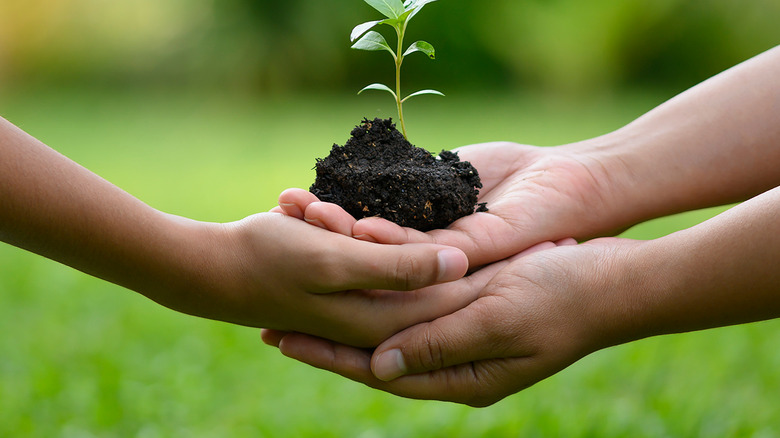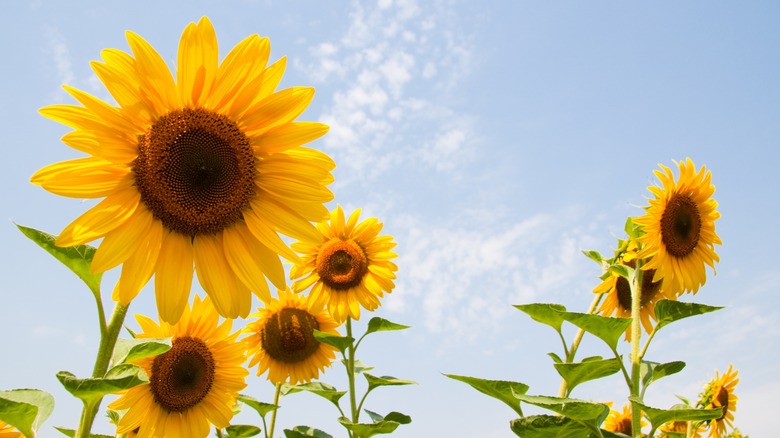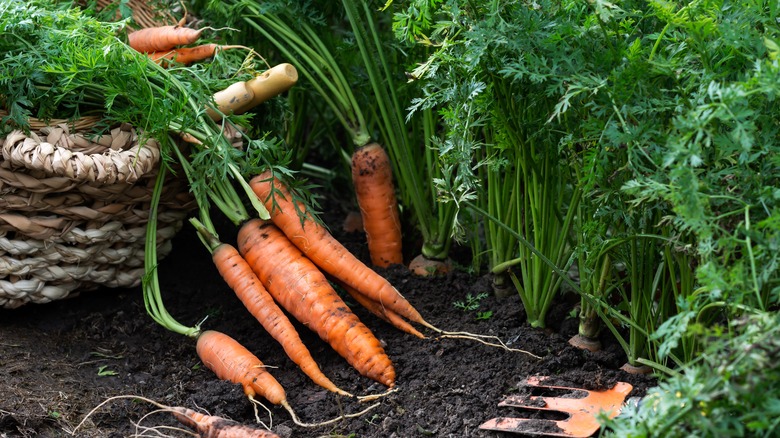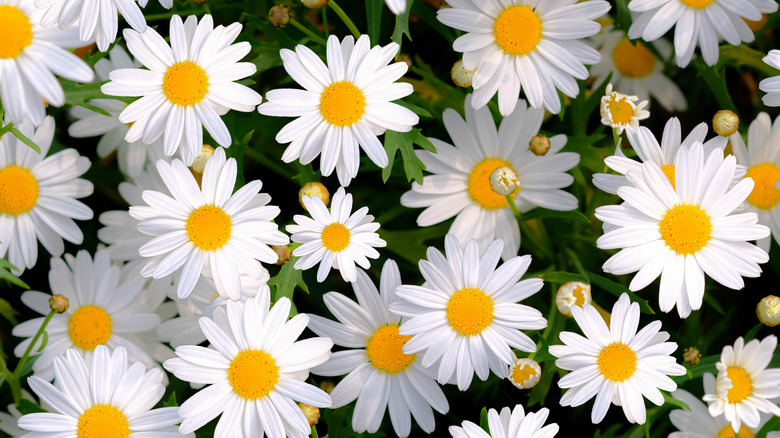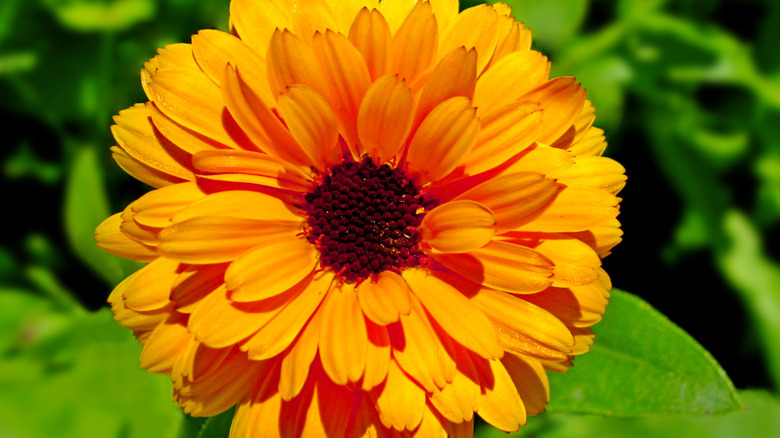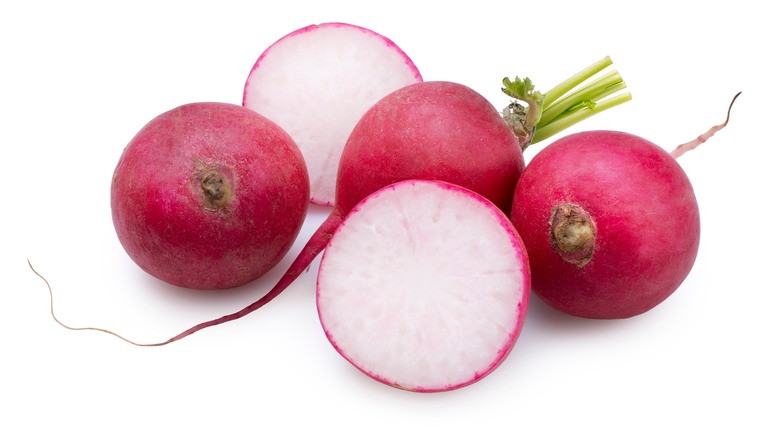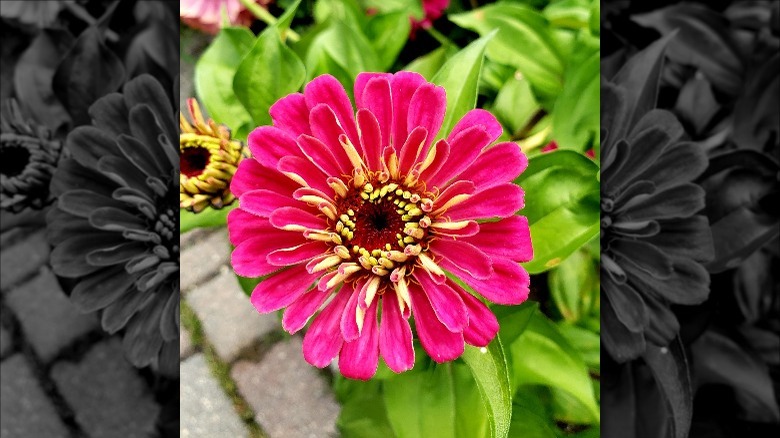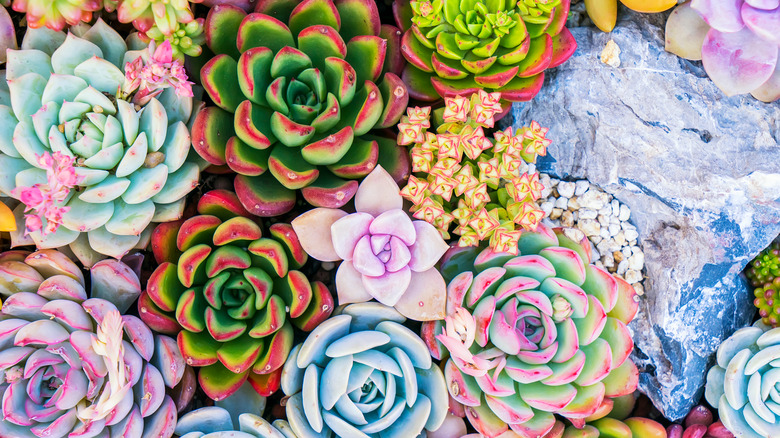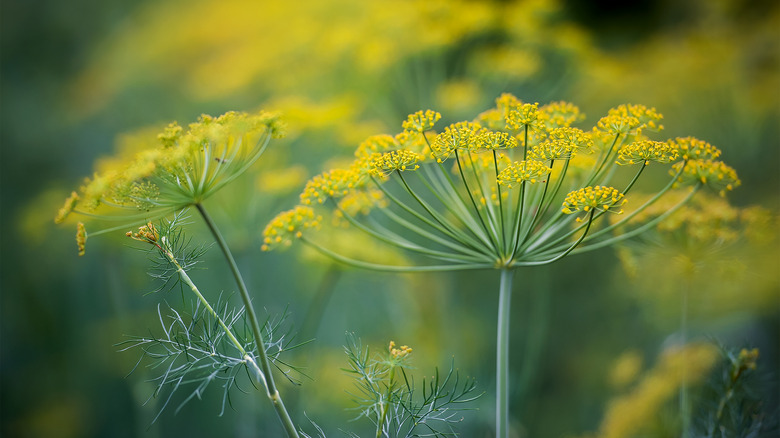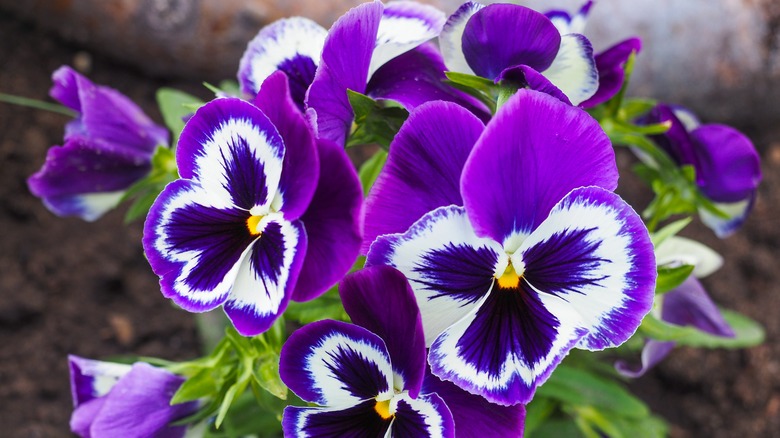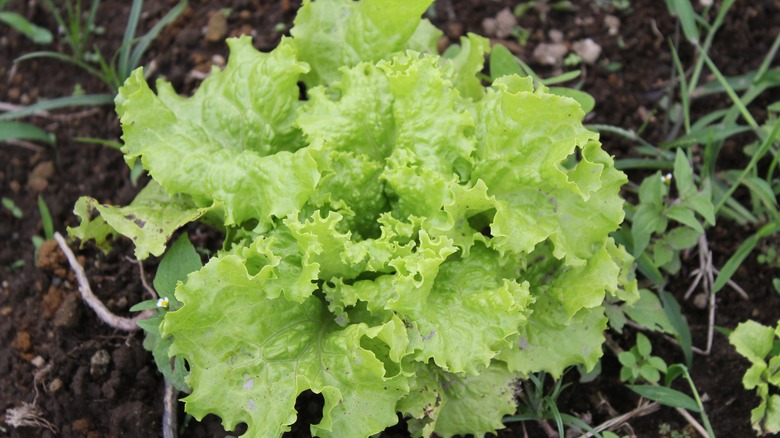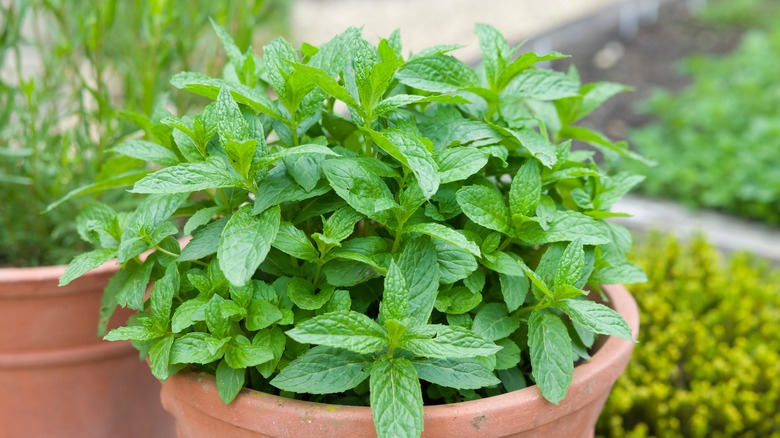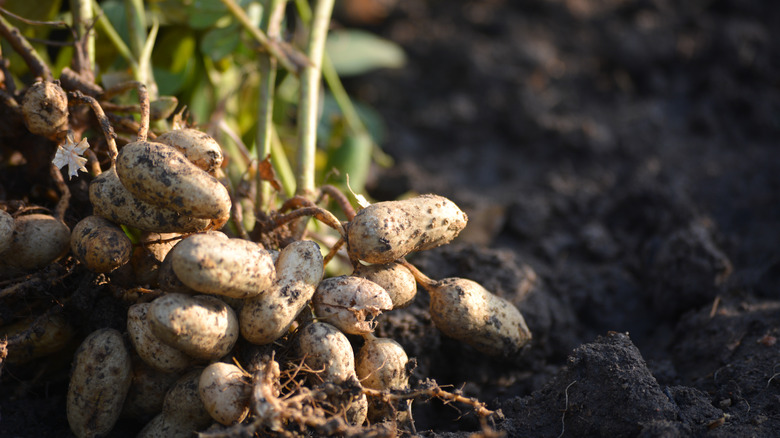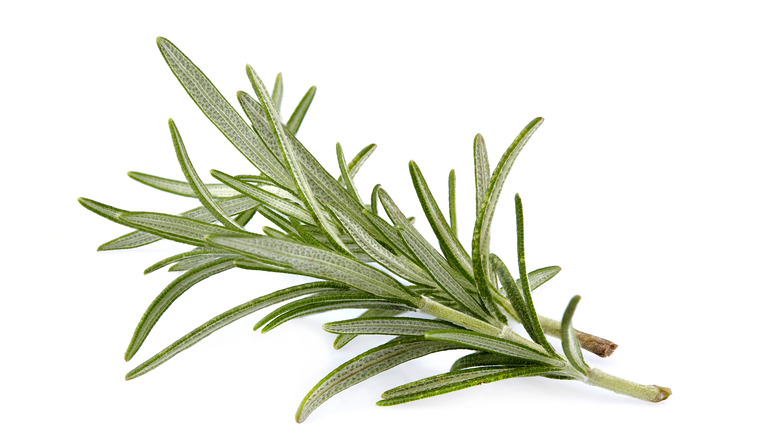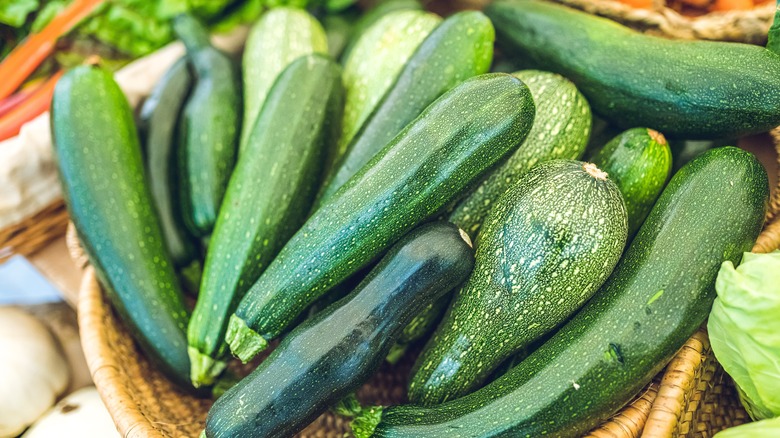15 Plants That You And Your Child Can Grow Together
Gardening is a wonderful hobby for any age. If you have a green thumb (or even if you don't yet), you and your child can plant various flowers and greenery together and reap a few benefits. First and foremost, gardening is a great bonding activity. It gets you both off of screens and back to the earth. According to PBS, growing plants together can also challenge your child's mind in various ways, from enriching math and other learning skills to boosting moods and preventing depression and anxiety.
Lastly, growing plants with your child can encourage healthy eating habits. Is your kid not excited about fruits and veggies? Help them grow their own and watch their interest develop as they become proud of their efforts and curious about the results. Best of all, there's a wide variety of plants available to try — many happily thrive in a variety of climates depending on the time of year. Here are some species to consider.
1. Sunflowers
Sunflowers (Helianthus) are the happiest of summer flowers and a great plant growing lesson for kids of all ages. According to Country Living, sunflowers come in many fun varieties. You don't need a whole lot of shade for them either — you should plant these giant blooms in direct sunlight after the frost season has ended. This makes them ideal for any garden type — all you need is soil and a fair bit of space for them to stretch to the sky.
Bloom Season: June-October
USDA Growing Zone: 4-9
Growing Conditions: Direct sun
Soil Type: Well-draining, moist
Size: 1-15 feet
2. Carrots
According to KinderCare, carrots (Daucus carota) are a rewarding plant for kids to grow because they come out orange and delicious when fully grown, and they sprout up cute and green early on. Your child will be excited to see quick progress and watch how the plant turns into a healthy snack. Carrots have a two-year cycle. You'll notice them flowering early in year two, bringing more exciting change.
Bloom Season: Year round
USDA Growing Zone: 3-10
Growing Conditions: Sunny location
Soil Type: Loose, rich in nutrients
Size: 2 inches
3. Shasta daisies
These happy little blooms come in so many sizes, types, and colors that one is sure to delight your child. A popular gardening choice for newbies is the shasta daisy (Leucanthemum × superbum). According to Birds & Blooms, your child will get a kick out of how quickly they sprout and grow, as well as being able to clip them once they mature and display them in a vase indoors.
Bloom Season: July-September
USDA Growing Zone: 4-9
Growing Conditions: Full sun with light shade
Soil Type: Well-draining, organically rich
Size: 2-3 feet tall, 1-2 feet wide
4. Marigolds
Marigolds (Calendulas) are bright, vibrant, and even edible flowers. According to Gilmour, kids will like their unique-looking seeds and the fact that you can grow beautiful blooms and use them in foods like salads. You can even use marigolds in herbal oils and DIY projects, which provides another quality time activity to partake in with your child.
Bloom Season: Within two months of planting. Plant the seeds 6-8 weeks prior to the last frost
USDA Growing Zone: 9-11
Growing Conditions: Partial shade to full sun
Soil Type: Regular
Size: 10-12 inches
5. Radishes
According to Little Sprouts Learning, radishes (Raphanus raphanistrum) are one of the easiest vegetables to grow. They are hard to kill and develop very quickly; you can expect them to go from sprout to harvest in about a month. For impatient little green thumbs, this can be an excellent choice. Since they can be grown in containers, they are ideal for even apartment gardens. There are many colors and varieties to try.
Bloom Season: Year round
USDA Growing Zone: 2-11
Growing Conditions: They don't like extreme heat
Soil Type: Well-draining, moist and sandy
Size: 4-14 inches
6. Zinnias
Zinnias are very low maintenance, can be cut and transferred into vases, and are wonderful flowers for garden pollinators. By planting them with your child, you will likely be able to show them bees, butterflies, and even hummingbirds, all of whom will frequent this tasty flower. According to Growing In The Garden, zinnias are sun lovers that don't enjoy wet leaves. If possible, use drip irrigation instead of simple overhead watering.
Bloom Season: April-November
USDA Growing Zone: 3-10
Growing Conditions: Plenty of sunshine
Soil Type: Rich soil with organic fertilizer
Size: 6 inches
7. Succulents
Have little of a green thumb yourself? Succulents (Crassulaceae) might be the answer if your child is interested in starting a garden, but you don't consider yourself having a lot of talent or time. Although they are slow-growing, succulents are also very forgiving. According to GardenersWorld, if you choose a spiked succulent like the lovely agave, it's best to plant it in a place that won't poke or injure children due to its exterior.
Bloom Season: Spring and summer
USDA Growing Zone: 3-11
Growing Conditions: Sunny, dry spot. Water once per week
Soil Type: Slightly acidic
Size: 28 inches
8. Dill
Dill (Anethum graveolens) is a plant ideal for children to grow because, according to Almanac, it likes to be watered freely. This is great for eager little gardeners that might go overkill with the garden hose or watering can. Dill can also be used to flavor many foods when harvested, including soup, bread, and salad dressings, providing you with plenty of fun kitchen projects with your little one.
Bloom Season: Late summer to early fall
USDA Growing Zone: 3-7 and 9-11
Growing Conditions: Full sun
Soil Type: Slightly acidic
Size: 3-5 feet tall
9. Pansies
Pansies (Viola tricolor var. hortensis) are adorable additions to any garden, and kids will delight in greeting their bloomed faces. They also come in many colors but as cute as they are, pansies can be a bit fickle. According to Kids Gardening, this is an easy option for gardens in with mild summers and winters. If your yard resides in a low-drama climate, give pansies a try and let your child select from various varieties.
Bloom Season: Spring and summer
USDA Growing Zone: 8-11
Growing Conditions: Full morning sun and shady afternoons
Soil Type: Well-draining, fertile
Size: 6-9 inches
10. Pumpkins
Pumpkins (Cucurbita pepo) need to be planted four months prior to Halloween. According to FamilyEducation, you'll want to pick a sunny spot and form hills out of the soil in which to plant the seeds. Each blossom will become a pumpkin, so you'll need to keep some and prune others. Pumpkins are a sweet and different way to grow a plant with your child that yields fun and festive results.
Bloom Season: Mid-June to early July
USDA Growing Zone: 3-7
Growing Conditions: Sunny, spacious area
Soil Type: Sandy is best
Size: 10-30 inches tall and 4-16 feet wide
11. Lettuce
Why go to the store to buy salad when you can grow lettuce right outside your door? Children can easily learn to cultivate this leafy vegetable that thrives in the sunshine. According to Growing Healthy Kids, you can even successfully grow it in a windowsill garden, making it a fun experience for apartment dwellers, too. When planting the seeds, the soil should be damp but never flooded, so be sure to help your children with their water moderation.
Bloom Season: Spring and fall
USDA Growing Zone: 2-11
Growing Conditions: Direct sunlight
Soil Type: Naturally acidic
Size: 20 inches
12. Mint
Mint (Mentha) is incredibly easy to grow. In fact, it can be a bit too easy as it often grows out of control. It smells wonderful and can be used in cooking, essential oils, etc. Plus, its small size and responsiveness to minimal care make it a strong choice for children. According to Bonnie Plants, if you plant mint in the ground instead of containers, it can spread quickly, so make sure it has plenty of room to grow.
Bloom Season: June to September
USDA Growing Zone: 3-8
Growing Conditions: Shady areas
Soil Type: Fertile
Size: 12-18 inches
13. Peanuts
Peanuts (Arachis hypogaea) are hardy plants, and just a single stalk can grow 30-40 nuts. According to the National Peanut Board, they are most easily grown in the South, but they can be cultivated in other regions if you get a head start. Expect them to take up to 120 days to mature and be ready to harvest — it's not a quick process, but it's a delicious one if you have a household of peanut lovers.
Bloom Season: Spring
USDA Growing Zone: 6-11
Growing Conditions: Full sun
Soil Type: Acidic and loamy
Size: 18 inches
14. Rosemary
Rosemary (Salvia rosmarinus) is a Mediterranean herb that makes so many foods flavorful. It's also fun to grow, and clipping off its aromatic sprigs can make any kitchen smell amazing. The more temperate the climate, the more robust the bush you can cultivate in your yard. If you don't have a lot of room, Bonnie Plants says that rosemary can also be grown indoors in smaller batches.
Bloom Season: Late spring to early summer
USDA Growing Zone: 7-10
Growing Conditions: Sunny, sheltered spot
Soil Type: High alkaline peat moss
Size: 4 feet tall and wide
15. Zucchini
When it comes to instant gratification gardening, it doesn't get much better than zucchini. This squash is easy to grow, and it grows very large quickly. According to The Educators' Spin On It, the male zucchini flowers appear before the female ones, and once both are out, you can teach the children how to spread pollen from the male to female flowers just as bees would. It's a great science lesson.
Bloom Season: 45 days after planting, ready to harvest in July
USDA Growing Zone: 3-9
Growing Conditions: Full sun
Soil Type: Organic
Size: 2-3.5 feet
